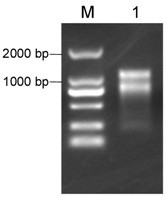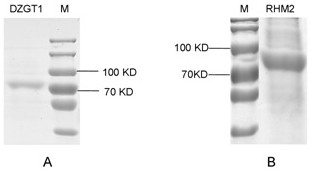Diosgenin glucoside rhamnosyltransferase as well as coding gene and application thereof
A technology of trillium murine and rhamnosyl, which is applied in the field of trillium rhamnosyltransferase and its coding gene and application, and can solve the problems that the rhamnosyltransferase gene has not yet been involved. To achieve the effect of broad application prospects
- Summary
- Abstract
- Description
- Claims
- Application Information
AI Technical Summary
Problems solved by technology
Method used
Image
Examples
Embodiment 1
[0024] Example 1. Obtaining the full-length cDNA sequence of the trillium rhamnosyltransferase gene.
[0025] 1. Extract the total RNA of Dioscorea scutellaria leaves ( figure 1 ).
[0026] The specific method is as follows: about 100 mg of Dioscorea scutellaria leaf samples were weighed, chopped and quickly ground in liquid nitrogen, and the ground sample powder was extracted with the EASYspin plus plant RNA rapid extraction kit (Beijing Aidelai). RNA.
[0027] 2. Reverse transcription of RNA into cDNA
[0028] RNA was reverse transcribed into cDNA using the RevertAid Reverse Transcription Kit (Thermo Scientific).
[0029] The specific method is as follows: Add the following components to an RNase-free PCR tube: RNA: 7.5 μl (about 1 μg), DNaseI: 1 μl, 10×DNase I buffer: 1 μl, RNase inhibitor: 0.5 μl. Mix the above substances and incubate at 37°C for 30min. Then add 1 μl of 50 mM EDTA and incubate at 65°C for 10 min to terminate the reaction. Add 1 μl Oligo (dT)18 (0.5 μ...
Embodiment 2
[0031] Example 2: Construction of recombinant expression vector containing trillinoside rhamnosyltransferase gene, expression and purification of recombinant protein.
[0032] Trillium rhamnosyltransferase gene ZGT1 Cloned into the multiple cloning site of pGEX-2T to obtain a recombinant plasmid, and fused the N-terminal of the glycosyltransferase protein with the GST tag. After heat shock, it was transferred into the prokaryotic expression strain E. coli BL21. After identification, a single colony was picked The culture was carried out and the expression of the recombinant protein was induced by IPTG, and the fusion protein was separated and purified by means of GST affinity chromatography column. Purified protein see image 3 a. The rhamnose synthase (Rhamnose synthase) gene RHM2 from Arabidopsis (rhamnose synthase RHM2 catalyzes the substrate UDP-glucose to generate UDP-rhamnose) was cloned into the multiple cloning site of pET-28a to obtain a recombinant plasmid , and ...
Embodiment 3
[0033] Example 3. Trillium rhamnosyltransferase catalyzes the reaction in vitro.
[0034] The in vitro enzyme reaction was carried out in 200 μl of Tris–HCl (50 mM, pH8.0) buffer at 30°C. The reaction system contained about 5 μg of purified DzGT1 protein (no DzGT1 protein was added in the control), and about 20 μg of RHM2 protein µg, 2 mMDTT, 2 mM NADPH, 2 mM UDP-glucose and 200 μM substrate. After the reaction, the reaction solution was extracted with ethyl acetate, evaporated to dryness and used for HPLC detection. HPLC detection results such as Figure 4As shown, in the control without enzyme DzGT1, no product peak was formed, but the product (peak 1) could be detected in the reaction solution added with DzGT1, and its retention time was consistent with that of dioscin A.
PUM
 Login to View More
Login to View More Abstract
Description
Claims
Application Information
 Login to View More
Login to View More - R&D
- Intellectual Property
- Life Sciences
- Materials
- Tech Scout
- Unparalleled Data Quality
- Higher Quality Content
- 60% Fewer Hallucinations
Browse by: Latest US Patents, China's latest patents, Technical Efficacy Thesaurus, Application Domain, Technology Topic, Popular Technical Reports.
© 2025 PatSnap. All rights reserved.Legal|Privacy policy|Modern Slavery Act Transparency Statement|Sitemap|About US| Contact US: help@patsnap.com



